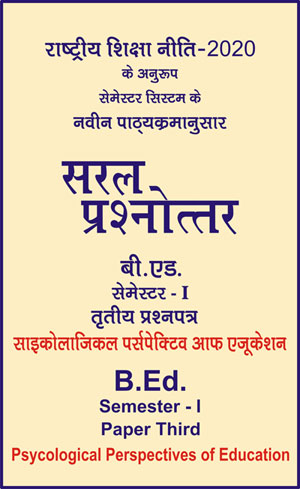|
बी एड - एम एड >> बी.एड. सेमेस्टर-1 प्रश्नपत्र-III - साइकोलाजिकल पर्सपेक्टिव आफ एजूकेशन बी.एड. सेमेस्टर-1 प्रश्नपत्र-III - साइकोलाजिकल पर्सपेक्टिव आफ एजूकेशनसरल प्रश्नोत्तर समूह
|
5 पाठक हैं |
|||||||
बी.एड. सेमेस्टर-1 प्रश्नपत्र-III - साइकोलाजिकल पर्सपेक्टिव आफ एजूकेशन (अंग्रेजी भाषा में)
Question- State-classification of motives given by Maslow.
Answer-
Motivation is much important in the field of psycho-education. This is the reason behind this that the psychologists have classified the term ‘Motivation’ as per their own convenience of thought. A few theories are elaborated as hereunder.
Classification of Motivation
M.K. Thomson has classified motives into two categories. According to him two fundamental forces of motivation takes place during course. The first one is Natural motives and the second one is Artificial motives. They are discussed as follows :
(1) Natural Motives - These motives are known as hereditary ones. Actually the human life is to be developed by hunger, thrust, security etc. motivational forces.
(2) Artificial Motives - These motives evolve in atmosphere. However, basically, these motives are based on natural motives but their forms happen to be change in the light of socialization. The best example of these motives are to acquire prestige in society, to maintain social relationship etc.
Classification of Maslow
The theory of Maslow and his classification in the field to motivation and teaching is of great significance. He has stressed much on necessities. Maslow has, in his study, taken speed of wants into his account. There may be a few wants, which could be fulfilled at a belated stage. For example, we can quote that a hungry person, at first, would like to have the food and later on he would think over about his safety and security. This programme is based on priority of needs or wants of man.
Maslow has devided motives into two parts a mentioned :
(1) Inborn Motives - In this section, we can quote hunger, thrust, security and sex etc.
(2) Acquired Motives - This system follows with the motives acquired from environment. He has sub-divided these acquired motives into two parts. The first one are social motives and the second one is individual motives. We can include the motives of socialization, combat and self-assertion. And the individual motives are consisting of habits, interest and unconscious motivation.
The classification of Karch and Cruchfield
This classification is based on deficiency and abundance of motives :
(1) Deficiency Motives : These motives help us in removing the deficiencies and short-falls of man. By adopting these motives, we can avoid mental struggle. According to Karch and Cruchfield, the motive of deficiency is related with wants by which we can remove fear, worries or any such kind of mental torture. The aim of this motive is to provide safety and security to man in the world.
(2) Abundancy : These motives are aimed at achieving zeal and satisfaction. The objects of motives are to get satisfaction, learning, invention and research etc.
|
|||||














